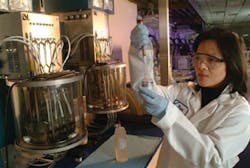With a single glance, even the most inexperienced eye can distinguish between fresh and used engine oil. But examine a sample of used oil carefully in the laboratory, and it will reveal a detailed snapshot of the engine's overall health. Is a bearing wearing down and shedding alloy fragments? Has corrosion penetrated the engine; creating ferrous oxide particles? Has somebody dropped a wire into the crankcase; an intruder which has since been shredded into surface-destroying shards? With the right analysis at facilities such as Aviation Laboratories or Jet-Care International, used lubricating oil will bear witness to these and other signs of engine problems.
"Given that it costs about $40 to test an engine oil sample, oil analysis is a very inexpensive way to find problems before they become serious and costly," says Josh Wagner, Jet-Care International's sales manager for North and South America. "After all, a bearing failure can completely scrap an engine if not detected in time."
Beyond providing immediate engine health snapshots, periodic oil analysis can help mechanics track a given engine's wear and tear over time. Such information can be especially helpful in spotting friction-caused wear soon after it begins, and in identifying potentially catastrophic failures long before they occur. It can also be useful in deciding whether an engine can be maintained based on its TBO schedule, or sent in for an early overhaul to keep it healthy.
One caution: To round out the picture, aircraft mechanics also need to periodically open and inspect used oil filters; and inspect the suction screen for debris as well. By doing so, they'll get a detailed look at what's happening inside the engine, and early warnings that could result in equipment-saving preventative maintenance.
What ends up in the oil
When we speak of dirty engine oil, what we are really saying is that there are suspended particles in this fluid. These particles have accumulated since the last oil change; swept up by the constant flow of oil past the engine's moving parts.
"These particles come from the normal wear-and-tear that an engine undergoes while in use, and from abnormal events that result in fragments being generated inside the engine," says Brian Costello; a field service engineer with Lycoming Engines. Included in these particles are everything from alloys being shed by bearings in normal use, to shavings coming off parts that shouldn't be grinding against each other, but are.
"Then there's silicon particles, a.k.a. dirt," Costello tells AMT. "These are elements that come from outside the engine through improperly sealed air intakes, since silicon is never used in the manufacture of engine parts. Since it is abrasive and accelerates wear, dirt is never a good thing to find."
In general, piston engines are the ones that benefit most from oil analysis, says Rory Hammond, president of Aviation Laboratories. This is because piston engines create significant amounts of extremely fine wear particles in the 0-20 micron size range that are detectable by oil analysis, because of the constant rubbing of cylinders, sleeves, bearings, and other mechanical parts against each other. This extremely fine wear circulates in the oil and is not trapped by filtration. The larger piston engine wear particles trapped in the oil filter must be monitored by oil filter analysis.
Turbine engines, on the other hand, have 10 micron oil filters or smaller, and generate predominantly larger wear particles greater than 10 microns, which are trapped by the oil filter. In regard to turbine engines, says Hammond, it is critical to perform both oil analysis and oil filter analysis, because most of the diagnostic evidence of abnormal turbine engine wear modes can be contained in the oil filter. Larger wear particles are analyzed by Scanning Electron Microscopy Energy Dispersive Spectroscopy, SEM EDS.
The process of oil analysis
Engine oil analysis begins with the collection of a sample by a mechanic; typically during a regular oil change. (In fact, some mechanics make oil analysis sampling a regular part of their oil change routine.)
"During the draining of engine oil, you place a collection bottle in the oil drain stream after about 2 quarts have drained," says Hammond. "In this way, the initial oil in the drain cleans the drain area out, and you capture a sample that reflects the overall content of the oil." He recommends taking a sample "every time the oil is changed," and doing so within 30 minutes of engine shutdown so that an ongoing history of the engine's wear can be compiled. The oil filter should also be cut open and inspected in the field and or sent to the laboratory for detailed analysis of the larger wear debris particles.
Once a sample has been collected, it is sent to a facility such as Aviation Laboratories or Jet-Care International. Here, the sample is analyzed using a process called Inductively Coupled Plasma Emission Spectrography, ICP for short.
In the ICP process, a plasma heat source vaporizes the particles within a sample of engine oil, breaking these particles down to their elemental atomic states. The atoms and ions contained in the plasma vapor are excited into a state of radiated light (photon) emission. As this plasma-driven breakdown occurs, changes take place within the electron orbital patterns of the atoms.
These electron changes cause the emission of element specific light signatures which are measure by the ICP. By analyzing the emitted light, and interpreting the elemental analysis, the analysts can determine precisely what the particles are made of; be it specific alloys, or contaminants such as silicon.
"In simplistic terms, we are identifying dissolved microscopic elements of metals suspended in the oil," says Costello. "Once we know what's there, we can tell the mechanic. They can use this data to decide whether the engine is performing properly, or if something is in there that needs followup."
The importance of checking oil filters and suction screens
"Oil analysis is a wonderful tool, but it doesn't replace a direct visual inspection of the oil filter and the suction screen," says Lycoming's Brian Costello. He's right: To get a complete picture of what's flowing through an engine, you need to take samples from the oil filter and suction screen. In the first instance, specially designed cutters are available to open metal filters without adding extra debris. In the second, it's a matter of going physically to the suction screen, and taking samples of what's on it.
In both cases, "You're looking for any significant amount of metal particles and any other materials that shouldn't be there," Costello says. Unless you have the knowledge and equipment to do the analysis yourself, the best option is to gather samples using laboratory-defined techniques, and send them off to be analyzed with your oil samples. "After all, it is virtually impossible to separate the different articles found in filter media by composition," says Hammond. "This is why we have to examine each one microscopically, so that we can determine the exact alloy by its appearance and distinctive shape."
Powerful preventative and diagnostic tool
"Benefits of oil analysis are there, but are difficult to quantify," says Jet-Care International's Josh Wagner. "Our oil testing might trigger a maintenance action that may cost $50,000 if the problem is caught in time, versus $1 million if it's not."
In fact, oil analysis is a very valuable aid in the never-ending process of monitoring engines during their operational life spans. Coupled with oil filter and suction screen inspections, oil analysis gives mechanics an opportunity to identify and remedy problems before they become serious.
Timely preventative maintenance doesn't just ease the drain on a client's wallet. In these tight economic times, preventing costly engine failures and AOG incidents could help thinly budgeted operators stay in business; thus keeping their mechanics employed as well.
This is why oil analysis is such an important part of engine maintenance. When used as part of a consistent, conscientious oil replacement program - in league with oil filter and suction screen inspections - oil analysis can truly help engines last longer, run better, and make a positive contribution to their owners' bottom lines.






